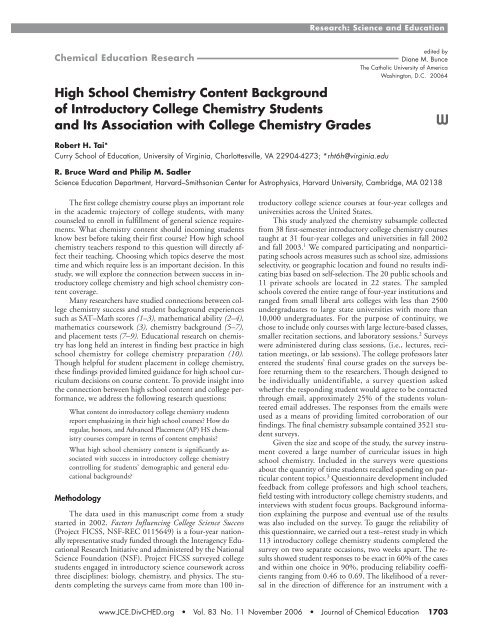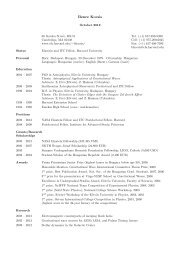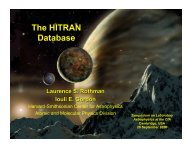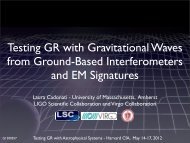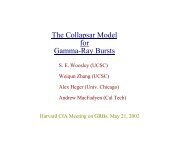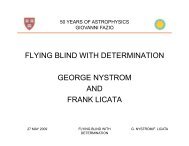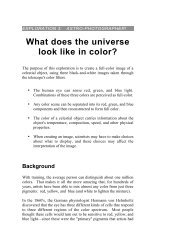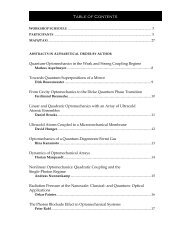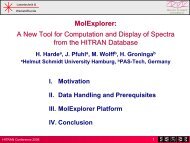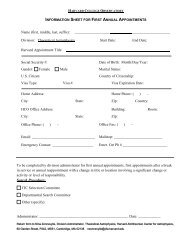High School Chemistry Content Background of Introductory College ...
High School Chemistry Content Background of Introductory College ...
High School Chemistry Content Background of Introductory College ...
You also want an ePaper? Increase the reach of your titles
YUMPU automatically turns print PDFs into web optimized ePapers that Google loves.
Research: Science and Education<br />
Chemical Education Research<br />
edited by<br />
Diane M. Bunce<br />
The Catholic University <strong>of</strong> America<br />
Washington, D.C. 20064<br />
<strong>High</strong> <strong>School</strong> <strong>Chemistry</strong> <strong>Content</strong> <strong>Background</strong><br />
<strong>of</strong> <strong>Introductory</strong> <strong>College</strong> <strong>Chemistry</strong> Students<br />
and Its Association with <strong>College</strong> <strong>Chemistry</strong> Grades<br />
W<br />
Robert H. Tai*<br />
Curry <strong>School</strong> <strong>of</strong> Education, University <strong>of</strong> Virginia, Charlottesville, VA 22904-4273; *rht6h@virginia.edu<br />
R. Bruce Ward and Philip M. Sadler<br />
Science Education Department, Harvard–Smithsonian Center for Astrophysics, Harvard University, Cambridge, MA 02138<br />
The first college chemistry course plays an important role<br />
in the academic trajectory <strong>of</strong> college students, with many<br />
counseled to enroll in fulfillment <strong>of</strong> general science requirements.<br />
What chemistry content should incoming students<br />
know best before taking their first course? How high school<br />
chemistry teachers respond to this question will directly affect<br />
their teaching. Choosing which topics deserve the most<br />
time and which require less is an important decision. In this<br />
study, we will explore the connection between success in introductory<br />
college chemistry and high school chemistry content<br />
coverage.<br />
Many researchers have studied connections between college<br />
chemistry success and student background experiences<br />
such as SAT–Math scores (1–3), mathematical ability (2–4),<br />
mathematics coursework (3), chemistry background (5–7),<br />
and placement tests (7–9). Educational research on chemistry<br />
has long held an interest in finding best practice in high<br />
school chemistry for college chemistry preparation (10).<br />
Though helpful for student placement in college chemistry,<br />
these findings provided limited guidance for high school curriculum<br />
decisions on course content. To provide insight into<br />
the connection between high school content and college performance,<br />
we address the following research questions:<br />
What content do introductory college chemistry students<br />
report emphasizing in their high school courses? How do<br />
regular, honors, and Advanced Placement (AP) HS chemistry<br />
courses compare in terms <strong>of</strong> content emphasis?<br />
What high school chemistry content is significantly associated<br />
with success in introductory college chemistry<br />
controlling for students’ demographic and general educational<br />
backgrounds?<br />
Methodology<br />
The data used in this manuscript come from a study<br />
started in 2002. Factors Influencing <strong>College</strong> Science Success<br />
(Project FICSS, NSF-REC 0115649) is a four-year nationally<br />
representative study funded through the Interagency Educational<br />
Research Initiative and administered by the National<br />
Science Foundation (NSF). Project FICSS surveyed college<br />
students engaged in introductory science coursework across<br />
three disciplines: biology, chemistry, and physics. The students<br />
completing the surveys came from more than 100 introductory<br />
college science courses at four-year colleges and<br />
universities across the United States.<br />
This study analyzed the chemistry subsample collected<br />
from 38 first-semester introductory college chemistry courses<br />
taught at 31 four-year colleges and universities in fall 2002<br />
and fall 2003. 1 We compared participating and nonparticipating<br />
schools across measures such as school size, admissions<br />
selectivity, or geographic location and found no results indicating<br />
bias based on self-selection. The 20 public schools and<br />
11 private schools are located in 22 states. The sampled<br />
schools covered the entire range <strong>of</strong> four-year institutions and<br />
ranged from small liberal arts colleges with less than 2500<br />
undergraduates to large state universities with more than<br />
10,000 undergraduates. For the purpose <strong>of</strong> continuity, we<br />
chose to include only courses with large lecture-based classes,<br />
smaller recitation sections, and laboratory sessions. 2 Surveys<br />
were administered during class sessions, (i.e., lectures, recitation<br />
meetings, or lab sessions). The college pr<strong>of</strong>essors later<br />
entered the students’ final course grades on the surveys before<br />
returning them to the researchers. Though designed to<br />
be individually unidentifiable, a survey question asked<br />
whether the responding student would agree to be contacted<br />
through email, approximately 25% <strong>of</strong> the students volunteered<br />
email addresses. The responses from the emails were<br />
used as a means <strong>of</strong> providing limited corroboration <strong>of</strong> our<br />
findings. The final chemistry subsample contained 3521 student<br />
surveys.<br />
Given the size and scope <strong>of</strong> the study, the survey instrument<br />
covered a large number <strong>of</strong> curricular issues in high<br />
school chemistry. Included in the surveys were questions<br />
about the quantity <strong>of</strong> time students recalled spending on particular<br />
content topics. 3 Questionnaire development included<br />
feedback from college pr<strong>of</strong>essors and high school teachers,<br />
field testing with introductory college chemistry students, and<br />
interviews with student focus groups. <strong>Background</strong> information<br />
explaining the purpose and eventual use <strong>of</strong> the results<br />
was also included on the survey. To gauge the reliability <strong>of</strong><br />
this questionnaire, we carried out a test–retest study in which<br />
113 introductory college chemistry students completed the<br />
survey on two separate occasions, two weeks apart. The results<br />
showed student responses to be exact in 60% <strong>of</strong> the cases<br />
and within one choice in 90%, producing reliability coefficients<br />
ranging from 0.46 to 0.69. The likelihood <strong>of</strong> a reversal<br />
in the direction <strong>of</strong> difference for an instrument with a<br />
www.JCE.DivCHED.org • Vol. 83 No. 11 November 2006 • Journal <strong>of</strong> Chemical Education 1703
Research: Science and Education<br />
Figure 1. An example <strong>of</strong> the actual survey questions.<br />
reliability coefficient <strong>of</strong> 0.40 in a group <strong>of</strong> 100 individuals is<br />
0.7% (11). This result indicates that survey reliability was<br />
acceptable.<br />
Students’ final introductory college chemistry grade<br />
(ICCGRADE) was used as the outcome measure. <strong>College</strong><br />
course grades carry with them the weight <strong>of</strong> a permanent<br />
record that may have a bearing on students’ future career<br />
prospects; something clearly understood by students.<br />
ICCGRADE represents a summative assessment <strong>of</strong> performance<br />
over an entire semester and is a common measure in<br />
previous studies (1, 3–5, 10).<br />
The control predictors used in this analysis fall into two<br />
groups: demographic identifiers and general educational background<br />
measures. The demographic identifiers include the<br />
following: gender, racial or ethnic background, parental education<br />
levels, average county household income, and high<br />
school type (i.e., public, private, magnet, charter, or parochial).<br />
Past studies have shown the importance <strong>of</strong> these predictors<br />
(12, 13). General educational background measures<br />
account for differences in academic achievement and relevant<br />
coursework. These variables included (i) SAT–Math scores,<br />
(ii) last high school (HS) mathematics grade, (iii) last HS<br />
science grade, (iv) last HS English grade, (v) type <strong>of</strong> HS calculus<br />
course taken (if any), and (vi) AP chemistry enrollment<br />
(if any).<br />
In choosing question predictors, the researchers consulted<br />
various sources including textbooks, high school teachers,<br />
and college pr<strong>of</strong>essors. The eight Time on Topic predictors<br />
were selected as representative <strong>of</strong> varying degrees <strong>of</strong> content<br />
emphasis:<br />
1. Atoms and the Periodic Table (Atoms)<br />
2. Chemical Reactions and Equations (Reactions)<br />
3. Solutions<br />
4. Gases and Gas Laws (Gas Laws)<br />
5. Stoichiometry<br />
6. Nuclear Reactions<br />
7. Biochemistry<br />
8. History and People <strong>of</strong> <strong>Chemistry</strong> (History).<br />
The topics were chosen to span the range from “fundamental”<br />
to “rarely included” in high school chemistry courses.<br />
Figure 1 shows an example <strong>of</strong> the actual survey questions.<br />
The analysis used multiple linear regression to produce an<br />
inferential statistical model assessing the significance <strong>of</strong> relationships<br />
between the Time on Topic predictors and the outcome,<br />
ICCGRADE, while controlling for background<br />
predictors.<br />
Since the survey spanned different courses in different<br />
schools, differences in grading practices would be expected.<br />
Including only lecture–recitation–laboratory formatted<br />
courses limited some differences. However, other institutional<br />
and course-based differences need to be accounted for, as well.<br />
To address this issue, a set <strong>of</strong> “dummy” variables was included<br />
in the model to account for college effects. The statistical<br />
power <strong>of</strong> this analytical method <strong>of</strong>fered a 90% chance <strong>of</strong> detecting<br />
a small effect (14).<br />
Incomplete questionnaires are not uncommon in largescale<br />
surveys. Typically, a questionnaire is excluded from the<br />
analysis, a tactic that introduces problems <strong>of</strong> data loss and<br />
biasing (15). In this study, missing data for the control predictors<br />
were imputed (16–18) to mitigate the problems imposed<br />
by systematic exclusion <strong>of</strong> incomplete surveys. Details<br />
on this approach are discussed in the Supplemental Material. W<br />
Results and Discussion<br />
Table 1 contains background data on the participating<br />
colleges and universities. Figures 2–4 show the distributions<br />
for the eight Time on Topic predictors. Figure 2 displays the<br />
graphs <strong>of</strong> the four high-occurrence predictors. A closer analysis<br />
<strong>of</strong> the graphs shows Atoms and Reactions have higher recurrence<br />
than Solutions and Gas Laws. This finding suggests<br />
that Solutions and Gases are typically included, but are fairly<br />
isolated within the curriculums, while Atoms and Reactions<br />
appear to be strong themes throughout high school chemistry.<br />
Figure 3 displays the distribution <strong>of</strong> the two moderate<br />
occurrence topics, Stoichiometry and History. The lower level<br />
<strong>of</strong> occurrence for Stoichiometry compared to Atoms and Reactions<br />
is somewhat surprising since the principles <strong>of</strong> stoichiometry<br />
are so closely associated with these two topics. A<br />
comparison <strong>of</strong> recurrence shows Stoichiometry and History<br />
have lower percentages than Atoms and Reactions, but higher<br />
percentages than Solutions and Gas Laws. Figure 4 displays<br />
the distributions for the low occurrence topics, Nuclear Reactions<br />
and Biochemistry.<br />
The findings suggest four classifications: (i) high occurrence–high<br />
recurrence for Atoms and Reactions, (ii) high occurrence–low<br />
recurrence for Solutions and Gas Laws, (iii)<br />
moderate occurrence–moderate recurrence for Stoichiometry<br />
and History, and (iv) low occurrence–low recurrence for<br />
Nuclear Reactions and Biochemistry. The classifications suggest<br />
that the content topics included in this analysis do span<br />
the range from fundamental (Atoms and Reactions) to fairly<br />
rare (Nuclear Reactions and Biochemistry).<br />
Table 2 shows the correlations among the eight content<br />
topics contained in the survey. 1 The highest correlation was<br />
found to be between Gas Laws and Solutions at r 0.610,<br />
considered a moderate correlation in social science research.<br />
These results suggest that many students who reported covering<br />
Gas Laws also reported covering Solutions. The next<br />
1704 Journal <strong>of</strong> Chemical Education • Vol. 83 No. 11 November 2006 • www.JCE.DivCHED.org
Research: Science and Education<br />
<strong>School</strong><br />
Table 1. Data on <strong>College</strong>s and Universities<br />
Participating in the Survey<br />
Participants<br />
Affiliation<br />
Avg.<br />
ACT<br />
Avg.<br />
SAT<br />
<strong>School</strong><br />
a<br />
Size<br />
State<br />
1 12<br />
Public<br />
23<br />
1080<br />
S NY<br />
2 13<br />
Public<br />
22<br />
1050<br />
M WV<br />
3 17<br />
Public<br />
22<br />
1050<br />
M TN<br />
4 21<br />
Public<br />
22<br />
1020<br />
M GA<br />
5 22<br />
Private<br />
21<br />
1010<br />
S PA<br />
6 23<br />
Private<br />
20<br />
0975<br />
S SC<br />
7 30<br />
Public<br />
20<br />
0970<br />
M KY<br />
8 34<br />
Private<br />
19<br />
0930<br />
S KY<br />
9 36<br />
Public<br />
23<br />
1080<br />
M NY<br />
10<br />
38<br />
Private<br />
22<br />
1050<br />
S AZ<br />
11<br />
39<br />
Public<br />
17<br />
0830<br />
S CA<br />
12<br />
43<br />
Private<br />
25<br />
1160<br />
S MI<br />
13<br />
43<br />
Private<br />
22<br />
1050<br />
S IL<br />
14<br />
48<br />
Private<br />
23<br />
1170<br />
S OR<br />
15<br />
57<br />
Public<br />
21<br />
0990<br />
S NH<br />
16<br />
59<br />
Public<br />
21<br />
1000<br />
M TX<br />
17<br />
60<br />
Public<br />
23<br />
1060<br />
S ME<br />
18<br />
68<br />
Private<br />
21<br />
1010<br />
S MI<br />
19<br />
84<br />
Public<br />
24<br />
1100<br />
M WA<br />
20<br />
88<br />
Private<br />
24<br />
1120<br />
S AL<br />
21<br />
94<br />
Public<br />
22<br />
1050<br />
S SD<br />
22<br />
118<br />
Public<br />
21<br />
1010<br />
L CA<br />
23<br />
120<br />
Private<br />
26<br />
1180<br />
S PA<br />
24<br />
134<br />
Public<br />
19<br />
0930<br />
M LA<br />
25<br />
155<br />
Public<br />
24<br />
1110<br />
L AZ<br />
26<br />
177<br />
Private<br />
26<br />
1200<br />
S IN<br />
27<br />
256<br />
Public<br />
23<br />
1080<br />
M ID<br />
28<br />
271<br />
Public<br />
24<br />
1120<br />
L LA<br />
29<br />
411<br />
Public<br />
27<br />
1210<br />
M MD<br />
30<br />
434<br />
Public<br />
21<br />
0990<br />
M IN<br />
31<br />
516<br />
Public<br />
24<br />
1120<br />
L KY<br />
Totals<br />
3521<br />
20/11<br />
a<br />
b<br />
---<br />
----<br />
4/11/<br />
16<br />
c 22<br />
966 participants were from small schools (< 5000 FTE), 1495 were<br />
from medium-size schools (5000–15,000 FTE), and 1060 were from<br />
b<br />
c<br />
large schools (>15,000 FTE). Public/private. Large/medium/small.<br />
Figure 2. Percentage <strong>of</strong> students in high occurrence topics.<br />
Figure 3. Percentage <strong>of</strong> students in moderate occurrence topics.<br />
highest correlation was found to be between Nuclear Reactions<br />
and Biochemistry at 0.597. The moderate correlation<br />
between Nuclear Reactions and Biochemistry is consistent<br />
with a common struggle between breadth and depth. The third<br />
highest correlation occurs between Atoms and Reactions.<br />
Next we consider differences across common levels <strong>of</strong><br />
high school chemistry: regular, honors, and Advanced Placement.<br />
The average Time on Topic across each <strong>of</strong> the eight<br />
content areas was calculated for these three levels <strong>of</strong> high<br />
school chemistry. In order to make this calculation, the following<br />
numerical values representing the number <strong>of</strong> estimated<br />
instructional days were assigned to each <strong>of</strong> the five categories:<br />
Not at All 0; A Few Weeks 15 days; A Month 20<br />
days; A Semester 40 days; Recurring Topic 40 days. 5 The<br />
results are shown in Figure 5. This format allows for fairly<br />
straightforward comparisons. However, these percentages do<br />
Figure 4. Percentage <strong>of</strong> students in low occurrence topics.<br />
not represent absolute percentages, since all possible chemistry<br />
topics were not included. A comparison <strong>of</strong> the relative<br />
percentages for regular and honors chemistry reveals them<br />
to be very similar. Small differences did appear for Atoms<br />
and Stoichiometry, where students in regular-level courses reported<br />
a greater focus on Atoms, while students in honorslevel<br />
courses reported a greater emphasis on Stoichiometry.<br />
A stronger quantitative focus in honors is not surprising; however,<br />
the small difference is surprising. Regular- and honorslevel<br />
chemistry appear to have very few differences in<br />
content-coverage patterns. When considering AP chemistry,<br />
www.JCE.DivCHED.org • Vol. 83 No. 11 November 2006 • Journal <strong>of</strong> Chemical Education 1705
Research: Science and Education<br />
Table 2. Correlations between <strong>Content</strong> Topics<br />
Atoms<br />
Reactions<br />
Solutions<br />
Gas<br />
Laws<br />
Stoichiometry<br />
Nuclear<br />
Reactions<br />
Biochemistry<br />
History<br />
Atoms<br />
Reactions<br />
Solutions<br />
Gas Laws<br />
Stoichiometry<br />
Nuclear Reactions<br />
Biochemistry<br />
History<br />
1 a b<br />
( 3284)<br />
0.579<br />
(3262)<br />
0.419<br />
(3237)<br />
0.322<br />
(3231)<br />
0.337<br />
(3237)<br />
0.201<br />
(3209)<br />
0.162<br />
(3223)<br />
0.195<br />
(3234)<br />
1<br />
(3275)<br />
0.565<br />
(3235)<br />
0.410<br />
(3231)<br />
0.524<br />
(3237)<br />
0.252<br />
(3208)<br />
0.191<br />
(3223)<br />
0.201<br />
(3233)<br />
1<br />
(3252)<br />
0.610<br />
(3231)<br />
0.435<br />
(3219)<br />
0.371<br />
(3191)<br />
0.310<br />
(3204)<br />
0.174<br />
(3211)<br />
1<br />
(3247)<br />
0.431<br />
(3214)<br />
0.512<br />
(3190)<br />
0.417<br />
(3204)<br />
0.202<br />
(3210)<br />
1<br />
(3253)<br />
0.302<br />
(3202)<br />
0.227<br />
(3216)<br />
0.177<br />
(3217)<br />
1<br />
(3225)<br />
0.597<br />
(3199)<br />
0.184<br />
(3198)<br />
1<br />
(3239)<br />
0.203<br />
(3216)<br />
1<br />
(3252)<br />
a<br />
ll correlations are significant at the 0.001 level (2-tailed test) .<br />
b<br />
A Sample sizes in parentheses.<br />
Figure 5. Comparison <strong>of</strong> relative content emphasis <strong>of</strong> selected topics<br />
across HS chemistry course levels.<br />
the emphasis appears to be lower for Atoms compared to both<br />
regular and honors chemistry. Not surprising given that all<br />
the students who reported taking AP chemistry also reported<br />
taking a regular or honors chemistry course. AP chemistry<br />
also tended to have a weaker emphasis on History, but a stronger<br />
emphasis appeared for Stoichiometry, a quantitative topic,<br />
and Nuclear Reactions, an advanced topic. These results are<br />
consistent with common expectations that AP chemistry is<br />
more quantitative and advanced than the other levels.<br />
Before continuing on to discuss the regression model, it<br />
is important to consider a methodological strategy used here<br />
when predictors did not have a normal distribution, as is the<br />
case with all eight Time on Topic predictors. These predictors<br />
cannot simply be entered in an analysis, since their distributions<br />
are non-normal and violate an initial condition for<br />
regression. A common tactic to overcome this problem is to<br />
convert these predictors into sets <strong>of</strong> binary variables. This<br />
approach is used for categorical predictors such as race or ethnicity<br />
and gender. Each response is used as a one component<br />
<strong>of</strong> a set <strong>of</strong> predictors, so for example None at All becomes<br />
a variable with two values, 0 or 1. Applying this<br />
approach produced eight sets <strong>of</strong> binary predictors or a<br />
“dummy variable” set. Each component <strong>of</strong> a dummy variable<br />
set may be compared with the other components, with<br />
one component held out <strong>of</strong> the model as the basis <strong>of</strong> comparison<br />
or a baseline. We chose the response, A Few Weeks,<br />
as the baseline for these eight sets (see the Supplemental<br />
Material W for a more detailed discussion).<br />
Multiple linear regression has the capacity to simultaneously<br />
analyze the connections among many variables and<br />
compare the explanatory power <strong>of</strong> the predictors, allowing<br />
for a variety <strong>of</strong> alternative hypotheses to be compared and<br />
background differences to be controlled for. Demographic<br />
differences are important to control for. Certainly, students’<br />
personal resources, such as parents with college backgrounds<br />
would be expected to have an impact on their performance<br />
in college. Students’ past academic records are important as<br />
well.<br />
Table 3 shows the regression model for the outcome<br />
ICCGRADE. Significant background predictors included<br />
students’ racial or ethnic background and parents’ highest<br />
educational level. Students’ year <strong>of</strong> college enrollment was<br />
only marginally significant when freshmen performance was<br />
compared to sophomores and not significant when compared<br />
to juniors and seniors. The significance <strong>of</strong> the racial and ethnic<br />
predictors reveals underachievement in minority groups<br />
traditionally underrepresented in chemistry, Hispanics and<br />
African Americans. Underachievement <strong>of</strong> African Americans<br />
is only marginally significant with underachievement <strong>of</strong> Hispanics<br />
showing stronger significance. Some studies have indicated<br />
complex social mechanisms that play important roles<br />
in student performance and persistence among students <strong>of</strong><br />
color (19). The outcome for Native Americans is significant;<br />
however, the sample only included 32 students. Further investigation<br />
<strong>of</strong> underrepresented minority groups is important<br />
though beyond the scope <strong>of</strong> this current manuscript.<br />
1706 Journal <strong>of</strong> Chemical Education • Vol. 83 No. 11 November 2006 • www.JCE.DivCHED.org
Research: Science and Education<br />
The regression model also found the following general<br />
educational background predictors to be significant: high<br />
school calculus enrollment, AP chemistry enrollment, quantitative<br />
(Math) and verbal SAT scores, and high school grades<br />
in science, English, and mathematics. All <strong>of</strong> these predictors<br />
appear as highly significant predictors <strong>of</strong> ICCGRADE except<br />
for SAT–Verbal. The analysis showed that Last HS English<br />
Grade appeared to subsume some <strong>of</strong> the variance in<br />
ICCGRADE accounted for by SAT–Verbal scores. Though<br />
not surprising, these results do form the backbone <strong>of</strong> many<br />
traditional hypotheses accounting for college chemistry performance.<br />
<strong>High</strong> school calculus enrollment, SAT–Math score, and<br />
Last HS Mathematics grade were all found to be highly significant<br />
in the same model indicating that each contributes<br />
independent predictive power for college chemistry success.<br />
The high -values <strong>of</strong> these three variables surpass those <strong>of</strong><br />
AP <strong>Chemistry</strong> and Time on Topic predictors and suggest that<br />
mathematics background is the most powerful predictor <strong>of</strong><br />
student performance found in this analysis.<br />
Turning our attention to the Time on Topic predictors,<br />
Table 3 shows that three <strong>of</strong> the eight content areas are significant<br />
predictors <strong>of</strong> ICCGRADE at the 0.05 level.<br />
The connection between these predictors and ICCGRADE<br />
is fairly complex. In the case <strong>of</strong> Gas Laws, the parameter<br />
estimates show no significant difference between students<br />
who reported having content related to this topic for the<br />
duration <strong>of</strong> A Few Weeks, A Month, or Not at All experience<br />
in high school chemistry. In contrast, the model predicts<br />
that students who report having a strong emphasis on<br />
Gas Laws have predicted college grades that are 1.5 points<br />
lower on the average. On the scale used for this analysis,<br />
1.5 points translates into about one sixth <strong>of</strong> a letter grade,<br />
a small effect.<br />
a<br />
Table 3. Regression Model including Categorical Predictors<br />
for HS <strong>Chemistry</strong> <strong>Content</strong> Topics<br />
Predictors<br />
B b SE<br />
b<br />
Constant<br />
40.57<br />
<strong>College</strong><br />
& University Dummy Variables<br />
Demographic and General Education Predictors<br />
Race<br />
or Ethnicity<br />
c<br />
Included<br />
b<br />
1.98<br />
---<br />
Not<br />
Reported<br />
0.05<br />
1.60<br />
0.00<br />
Native<br />
American 4.18<br />
e<br />
1.77<br />
0.03<br />
Asian<br />
0.07<br />
0.64<br />
0.00<br />
Black<br />
1.48<br />
f<br />
0.76<br />
0.03<br />
Multi-racial<br />
1.03<br />
1.07<br />
0.01<br />
Hispanic<br />
3.49<br />
<strong>High</strong>est<br />
Parent Education Level<br />
0.47<br />
Year<br />
in <strong>College</strong><br />
HS<br />
Calculus Enrollment<br />
Sophomore<br />
0.82<br />
c<br />
d<br />
f<br />
0.81<br />
0.07<br />
0.16<br />
0.05<br />
0.45<br />
0.03<br />
Junior<br />
0.21<br />
0.61<br />
0.01<br />
Senior<br />
0.03<br />
0.92<br />
0.00<br />
Regular<br />
1.73<br />
AP–A/B<br />
option 3.00<br />
AP–B/C option 4.31<br />
AP<br />
<strong>Chemistry</strong> Enrollment<br />
2.90<br />
SAT<br />
Last<br />
HS Grade in...<br />
<strong>Content</strong> Coverage Predictors<br />
Gas<br />
Laws<br />
Stoichiometry<br />
Nuclear<br />
Reactions<br />
a<br />
Math<br />
0.02<br />
Science<br />
1.68<br />
English<br />
1.10<br />
Mathematics<br />
2.83<br />
c<br />
c<br />
c<br />
c<br />
c<br />
c<br />
c<br />
c<br />
0.50<br />
0.06<br />
0.46<br />
0.11<br />
0.76<br />
0.09<br />
0.56<br />
0.08<br />
0.00<br />
0.15<br />
0.27<br />
0.11<br />
0.31<br />
0.06<br />
0.26<br />
0.19<br />
Not<br />
at All<br />
0.74<br />
0.65<br />
0.02<br />
A Month<br />
0.16<br />
0.48<br />
0.01<br />
Recurring<br />
Topic 1.53<br />
Not<br />
at All<br />
2.49<br />
e<br />
c<br />
0.76<br />
0.04<br />
0.56<br />
0.08<br />
A Month<br />
0.09<br />
0.48<br />
0.00<br />
Recurring<br />
Topic 2.63<br />
Not<br />
at All<br />
0.62<br />
c<br />
f<br />
0.50<br />
0.10<br />
0.37<br />
0.03<br />
A Month<br />
0.68<br />
0.71<br />
0.02<br />
Recurring<br />
Topic 3.98<br />
c<br />
1.03<br />
0.07<br />
Dependent variable: introductory college chemistry course grade (A+ = 98, A = 95, A- = 91,<br />
B+<br />
= 88, etc.); R 2 = 0.355; Adj.<br />
R 2 = 0.341; Sample size = 3093.<br />
b B , parameter estimate;<br />
SE,<br />
standard error <strong>of</strong> the parameter estimate; , standardized parameter estimate.<br />
c p < 0.001.<br />
d p < 0.01.<br />
e p < 0.05.<br />
f p < 0.10.<br />
www.JCE.DivCHED.org • Vol. 83 No. 11 November 2006 • Journal <strong>of</strong> Chemical Education 1707
Research: Science and Education<br />
Stoichiometry background was found to be a much<br />
stronger predictor. Students reporting None at All were predicted<br />
to have a grade 2.5 points lower than the baseline <strong>of</strong><br />
A Few Weeks, which translates to one quarter <strong>of</strong> a letter grade.<br />
Students who reported a heavy emphasis (i.e., recurring topic)<br />
were predicted to earn grades 2.6 points higher than the baseline,<br />
about one-quarter <strong>of</strong> a letter grade. Comparing heavy<br />
emphasis students to students reporting no Stoichiometry,<br />
heavy emphasis students were predicted to outperform their<br />
peers by half <strong>of</strong> a letter grade, on the average. No significant<br />
difference appeared between students reporting A Few Weeks<br />
versus A Month.<br />
For the topic <strong>of</strong> Nuclear Reactions, the regression analysis<br />
shows that students reporting less emphasis on this topic typically<br />
have higher levels <strong>of</strong> performance. In fact, the regression<br />
results suggest that students reporting no Nuclear<br />
Reactions backgrounds in high school more typically earned<br />
higher college chemistry grades, while those reporting a heavy<br />
emphasis have college grades on the average, nearly half <strong>of</strong> a<br />
letter grade below their peers. Rather than finding the study<br />
<strong>of</strong> advanced topics is associated with later success, we find<br />
no particular benefit to making it through to the final chapters<br />
<strong>of</strong> the textbook. The number <strong>of</strong> heavy emphasis students<br />
totaled 132 (4% <strong>of</strong> the sample); though small, this total does<br />
provide enough representation to reveal significance.<br />
The other five chemistry content topics were not found<br />
to be associated with introductory college chemistry grades.<br />
These topics were: Atoms, Reactions, Solutions, History, and<br />
Biochemistry. For Atoms and Reactions, only a few students<br />
selected the None at All response category. Here the comparison<br />
among the categorical predictors amounted to a comparison<br />
among students reporting A Few Weeks, A Month,<br />
and Recurring Topic. Atoms and Reactions are fundamental<br />
to chemistry understanding, and this result might be indicative<br />
<strong>of</strong> the pervasiveness <strong>of</strong> these topics. No difference is found<br />
between students who reported explicitly returning to these<br />
topics through out the semester versus others who reported<br />
A Few Weeks or A Month <strong>of</strong> coverage.<br />
For Solutions and History, each reported substantial<br />
numbers <strong>of</strong> responses in all four categories, allowing each category<br />
to be strongly represented in the analysis. Particularly<br />
surprising is the absence <strong>of</strong> History as a significant predictor.<br />
It is to note that college chemistry grades may not be<br />
sensitive to the influence <strong>of</strong> history, <strong>of</strong>ten cited as a topic providing<br />
context, perspective, and generating student interest.<br />
Studies on student continuation in chemistry coursework<br />
might be more revealing. Finally, for Biochemistry, 109 individuals<br />
selected the heavy emphasis choices (3.5% <strong>of</strong> the<br />
sample); enough for the analysis, but unlike Nuclear Reactions,<br />
no significant results were found.<br />
Table 4. Categorical Predictors’ Ranges and Continuous Predictors’ Ranges,<br />
Averages, and Standard Deviations<br />
Predictor<br />
Race<br />
or Ethnicity<br />
Min<br />
M ax<br />
Ave (s.d.)<br />
Not<br />
Reported<br />
0 1 Categorical<br />
Native<br />
American 0 1 Categorical<br />
Asian<br />
0 1 Categorical<br />
Black<br />
0 1 Categorical<br />
Multi-racial<br />
0 1 Categorical<br />
Hispanic<br />
0 1 Categorical<br />
<strong>High</strong>est<br />
Parent Education Level<br />
0 4 2.73 (1.10)<br />
Year<br />
in <strong>College</strong><br />
HS<br />
Calculus Enrollment<br />
Sophomore<br />
0 1 Categorical<br />
Junior<br />
0 1 Categorical<br />
Senior<br />
0 1 Categorical<br />
Regular<br />
0 1 Categorical<br />
AP–A/B<br />
option 0 1 Categorical<br />
AP–B/C option 0 1 Categorical<br />
AP<br />
<strong>Chemistry</strong> Enrollment<br />
0 1 Categorical<br />
SAT<br />
Last<br />
HS Grade in...<br />
Gas<br />
Laws<br />
Stoichiometry<br />
Nuclear<br />
Reactions<br />
Math<br />
220<br />
790<br />
590 (100)<br />
Science<br />
1 5 4.4 (0.8)<br />
English<br />
1 5 4.6 (0.6)<br />
Mathematics<br />
2 5 4.3 (0.8)<br />
Not<br />
at All<br />
0 1 Categorical<br />
A Month<br />
0 1 Categorical<br />
Recurring<br />
0 1 Categorical<br />
Not<br />
at All<br />
0 1 Categorical<br />
A Month<br />
0 1 Categorical<br />
Recurring<br />
0 1 Categorical<br />
Not<br />
at All<br />
0 1 Categorical<br />
A Month<br />
0 1 Categorical<br />
Recurring<br />
0 1 Categorical<br />
1708 Journal <strong>of</strong> Chemical Education • Vol. 83 No. 11 November 2006 • www.JCE.DivCHED.org
Research: Science and Education<br />
A regression model is actually a multidimensional linear<br />
equation where the parameter estimates (shown in Table<br />
3) are the coefficients <strong>of</strong> the variables shown in Table 4. Written<br />
out, the linear equation is fairly extensive.<br />
ICCGRADE 40.57 0.05(Race Not Reported) <br />
4.18(Race Native American) 0.07(Race Asian) ... <br />
0.47(<strong>High</strong>est Parent Education Level) 0.82(Year in<br />
<strong>College</strong>: Sophomore) ... 1.73(HS Calculus Enrollment<br />
Regular) 3.00(HS Calculus Enrollment AP A/B)<br />
... 2.90(AP <strong>Chemistry</strong> Enrollment) 0.02(SAT–<br />
Math Score) 1.68(Last HS Science Grade) ... <br />
0.74(Gas Laws: None) 0.16(Gas Laws: A Month) <br />
1.53(Gas Laws: Recurring Topic) ....<br />
However, calculations are fairly straightforward. For example,<br />
suppose we wish to compare two prototypical students: Student<br />
A who had stoichiometry as a recurring topic in high<br />
school and Student B who had no stoichiometry. Suppose<br />
these students have the same background characteristics in<br />
every other way. Table 5 displays a comparison <strong>of</strong> the two<br />
linear equations used to produce the predicted ICCGRADE.<br />
The results predict a final grade <strong>of</strong> 84.26 for Student A and<br />
79.16 for Student B: B, and C, respectively. Other predictions<br />
may be made by using the regression model in a similar<br />
fashion.<br />
Conclusions<br />
Based on this analysis, we found Stoichiometry to be the<br />
one chemistry topic among a group <strong>of</strong> eight to be an important<br />
predictor <strong>of</strong> college chemistry performance. 6 The predicted<br />
grade <strong>of</strong> students who reported a heavy emphasis on<br />
stoichiometry was 2.6 points higher than their peers who reported<br />
studying stoichiometry for A Few Weeks or A Month.<br />
However, compared to students who reported no stoichiometry,<br />
the heavy emphasis students were predicted to earn<br />
grades 5.1 points higher. Class time and emphasis committed<br />
to stoichiometry varies widely in high school. Both the<br />
textbooks and classroom practice reflect this variation. We<br />
found evidence <strong>of</strong> a continuum in the survey responses with<br />
students reporting stoichiometry content experiences that<br />
ranged from Not at All to a Recurring theme throughout their<br />
high school chemistry course. Comparing high school to college<br />
chemistry content emphases, stoichiometry is seldom<br />
Table 5. Comparison <strong>of</strong> Predicted ICCGRADE for Two Prototypical Students<br />
a<br />
Predictor<br />
B Student<br />
A Student B<br />
Constant<br />
40.57<br />
1 1<br />
Race<br />
or Ethnicity<br />
Not<br />
Reported<br />
0.05<br />
0 0<br />
Native<br />
American 4.18<br />
0 0<br />
Asian<br />
0.07<br />
0 0<br />
Black<br />
1.48<br />
0 0<br />
Multi-racial<br />
1.03<br />
0 0<br />
Hispanic<br />
3.49<br />
0 0<br />
<strong>High</strong>est<br />
Parent Education Level<br />
0.47<br />
3 3<br />
Year<br />
in <strong>College</strong><br />
HS<br />
Calculus Enrollment<br />
Sophomore<br />
0.82<br />
0 0<br />
Junior<br />
0.21<br />
0 0<br />
Senior<br />
0.03<br />
0 0<br />
Regular<br />
1.73<br />
1 1<br />
AP–A/B<br />
option 3.00<br />
0 0<br />
AP–B/C option 4.31<br />
0 0<br />
AP<br />
<strong>Chemistry</strong> Enrollment<br />
2.90<br />
1 1<br />
SAT<br />
Last<br />
HS Grade in...<br />
Gas<br />
Laws<br />
Stoichiometry<br />
Nuclear<br />
Reactions<br />
Math<br />
0.02<br />
590<br />
590<br />
Science<br />
1.68<br />
4 4<br />
English<br />
1.10<br />
4 4<br />
Mathematics<br />
2.83<br />
4 4<br />
Not<br />
at All<br />
0.74<br />
0 0<br />
A Month<br />
0.16<br />
1 1<br />
Recurring<br />
Topic 1.53<br />
0 0<br />
Not<br />
at All<br />
2.49<br />
0 1<br />
A Month<br />
0.09<br />
0 0<br />
Recurring<br />
Topic 2.63<br />
1 0<br />
Not<br />
at All<br />
0.62<br />
1 1<br />
A Month<br />
0.68<br />
0 0<br />
Recurring<br />
Topic 3.98<br />
0 0<br />
b<br />
Predicted<br />
ICCGRADE<br />
84.26<br />
79.14<br />
aStudent<br />
A with stoichiometry as a recurring topic in HS chemistry and Student B with no stoichiometry. Both<br />
b<br />
prototypical<br />
students are white, have a parent that graduated from college and are freshmen. Predicted<br />
ICCGRADE: A+ = 98, A = 95, A- = 91, B+ = 88, B = 85, B- = 81, C+ = 78, C = 75, C- = 71, etc.<br />
www.JCE.DivCHED.org • Vol. 83 No. 11 November 2006 • Journal <strong>of</strong> Chemical Education 1709
Research: Science and Education<br />
studied before the second quarter <strong>of</strong> the academic year. However,<br />
in college chemistry, students need to master stoichiometric<br />
calculations very early, <strong>of</strong>ten by the first or second week<br />
<strong>of</strong> the first course. In college chemistry textbooks, the topic<br />
is generally introduced by the third chapter. Some high school<br />
chemistry curricula and textbooks have chosen to take a qualitative<br />
or conceptually-based approach, de-emphasizing stoichiometry.<br />
The study <strong>of</strong> stoichiometry necessarily includes<br />
the application <strong>of</strong> mathematics, which also appears as a highly<br />
significant predictor <strong>of</strong> college performance.<br />
The influence <strong>of</strong> mathematics is evident in light <strong>of</strong> the<br />
significance <strong>of</strong> three predictors: HS Calculus Enrollment<br />
(regular, Advanced Placement A/B, or B/C), SAT–Math<br />
score, and Last HS Mathematics Grade as predictors. A surprising<br />
finding is the importance <strong>of</strong> calculus enrollment. Why<br />
does calculus appear to be so valuable in introductory college<br />
chemistry, especially since courses typically require few,<br />
if any, calculus applications? Our view is that facility with<br />
solving simple equations and comprehending graphs, an essential<br />
skill in college chemistry, over time and with practice.<br />
While advanced mathematics is not used in introductory<br />
chemistry, studying topics such as calculus in high school<br />
raises the likelihood that students show fluency in algebra<br />
with no scaffolding or teacher-support. In college, students<br />
who have not acquired these skills with full mastery are at a<br />
substantial disadvantage, since chemistry pr<strong>of</strong>essors do not<br />
“hand-hold” students with weak mathematical skills. Instead,<br />
pr<strong>of</strong>essors assume that students enrolled in their classes possess<br />
the pr<strong>of</strong>iciency to follow lectures and comprehend text<br />
passages without assistance regarding mathematical symbols<br />
and equations. Lack <strong>of</strong> fluency in mathematics, the “language<br />
<strong>of</strong> science”, handicaps introductory chemistry students, just<br />
as being a tourist in a foreign land limits one’s experience if<br />
you do not know the local language.<br />
Taking this discussion a step further, we wondered<br />
whether college chemistry students would specifically mention<br />
the term “stoichiometry” on their own if asked about<br />
their chemistry learning experiences. Therefore, to provide<br />
some limited qualitative corroboration <strong>of</strong> our statistical findings,<br />
we searched supplementary post-survey emails from respondents<br />
who completed our original survey and granted<br />
us permission to contact them with follow up questions.<br />
Among others, students were asked the following question:<br />
What aspects <strong>of</strong> your high school chemistry course helped<br />
you most in college? The following are excerpts from the responses<br />
<strong>of</strong> six students that specifically used the term stoichiometry:<br />
I think stoichiometry gave a lot <strong>of</strong> kids trouble so I think<br />
my fairly strong background with that gave me a heads up.<br />
...stoichiometry—I learned that really well in high school<br />
and I remembered it all throughout chemistry.<br />
...knowledge about stoichiometry from high school chemistry<br />
helped me most.<br />
I’d have to say stoichiometry because quite a few people<br />
had problems with that.”<br />
...stoichiometry and the ability to apply conversions helped<br />
the most.<br />
...most helpful was the depth [with which] we covered<br />
stoichiometry....<br />
These responses summarize the impact <strong>of</strong> stoichiometry in<br />
college chemistry. For the high school chemistry teachers who<br />
choose to spend more time on stoichiometry and less time<br />
on other more advanced topics, the results support their decision<br />
and suggest that this practice gives their students a significant<br />
advantage in introductory college chemistry.<br />
Acknowledgments<br />
The authors would like to acknowledge Janice Earle,<br />
Barry Sloane, and Larry Suter <strong>of</strong> the National Science Foundation<br />
for their insight and guidance for Project FICSS and<br />
the contributions <strong>of</strong> Marc Schwartz, Zahra Hazari, John<br />
Loehr, Cynthia Crockett, Harold Coyle, Annette Trenga, and<br />
Michael Filisky who were invaluable to the production <strong>of</strong> this<br />
manuscript. Also, the review and comments <strong>of</strong> Tom Pratuch<br />
<strong>of</strong> Annadale <strong>High</strong> <strong>School</strong> <strong>of</strong> Annadale, Virginia and A. Ian<br />
Harrison <strong>of</strong> University <strong>of</strong> Virginia both led to significant<br />
changes and additions to this manuscript. Finally, we wish<br />
to acknowledge the contribution <strong>of</strong> the thousands <strong>of</strong> introductory<br />
college students and their pr<strong>of</strong>essors who took the<br />
time to thoughtfully complete the surveys and the pilot surveys<br />
that made this analysis possible.<br />
W Supplemental Material<br />
A method to deal with missing data and an analytical<br />
approach for using non-normally distributed variables are discussed<br />
in this issue <strong>of</strong> JCE Online.<br />
Notes<br />
1. These schools are a subset <strong>of</strong> 67 selected through stratified<br />
random sampling based on school size from a comprehensive list<br />
<strong>of</strong> nearly 1700 four-year colleges and universities in the United<br />
States. Since nearly half <strong>of</strong> all students attending four-year colleges<br />
and universities are enrolled in only 10% <strong>of</strong> the country’s higher<br />
institutions, stratified random sampling ensured that the sample<br />
would be nationally representative. The chemistry departments <strong>of</strong><br />
all selected schools were contacted and asked to participate. Instructors<br />
at 31 schools agreed.<br />
2. This format is by far the most ubiquitous and thus the format<br />
most likely to be experienced by introductory chemistry students.<br />
3. Though retrospective self-report surveys are very common<br />
and include the National Assessment <strong>of</strong> Education Progress and the<br />
National Educational Longitudinal Survey <strong>of</strong> 1988, limitations are<br />
important to consider and include accuracy and reliability. Conclusions<br />
from early research questioning accuracy and reliability (20)<br />
have shifted in light <strong>of</strong> more recent studies that suggest memory and<br />
recall can be quite reliable even over extended periods <strong>of</strong> time when<br />
contextual cues are provided (20–22). Other researchers (23–26) have<br />
identified several additional factors to improve recall that include:<br />
proper wording <strong>of</strong> questions, grouping questions into conceptually<br />
related sequences, providing contextual cues within the questionnaire,<br />
surveying students in situations and surroundings associated with<br />
the topic, and making the survey relevant to the students. The survey<br />
methodology accounted for all <strong>of</strong> these factors.<br />
4. Apart from revealing associations among the content topics,<br />
a correlation analysis provides some details regarding associa-<br />
1710 Journal <strong>of</strong> Chemical Education • Vol. 83 No. 11 November 2006 • www.JCE.DivCHED.org
Research: Science and Education<br />
tions among the predictors and provides some hints to the problem<br />
<strong>of</strong> multicollinearity in the regression analyses that may play<br />
havoc with the significance statistics and produce misleading results.<br />
Checking correlations provides one means <strong>of</strong> detecting this<br />
problem; another means <strong>of</strong> detection includes a systematic and careful<br />
approach to the inclusion <strong>of</strong> variables in each regression model.<br />
5. The values were chosen as fractions <strong>of</strong> a 180 day school<br />
year, consisting <strong>of</strong> 36 weeks or 9 months. Dividing 180 days by 9<br />
months produces a value <strong>of</strong> 20 days for each month. The category<br />
<strong>of</strong> A Few Weeks was given the value <strong>of</strong> 15 days, five school days<br />
shorter than a month. The categories for A Month and Recurring<br />
Topic were chosen to represent two differing approaches to instruction,<br />
highly intensive, long term content focus and repeated exposure<br />
to content over an extended period <strong>of</strong> time. Both <strong>of</strong> these<br />
categories were intended to represent long time commitments to<br />
particular content areas. Therefore, rather, the distinguishing characteristic<br />
between these two categories was not actual time, but the<br />
formatting <strong>of</strong> the time. Thus for the purposes <strong>of</strong> this calculation,<br />
the categories, A Month and Recurring Topic, were given a value<br />
twice as large as the value for a month, i.e., 40 days.<br />
6. Some readers might wonder whether the students surveyed<br />
in our study would know the term stoichiometry. The students participating<br />
in this study were typically surveyed 4–10 weeks into an<br />
introductory college chemistry course at a four-year college or university<br />
and all students included in this analysis also reported having<br />
had at least one high school chemistry course. This level <strong>of</strong><br />
formal chemistry education suggests that students would be very<br />
likely to be familiar with this term.<br />
Literature Cited<br />
1. Spencer, H. E. J. Chem. Educ. 1996, 73, 1150–1153.<br />
2. House, J. D. Res. <strong>High</strong>er Educ. 1995, 36, 473–490.<br />
3. Ozsogomonoyan, A.; L<strong>of</strong>tus, D. J. Chem. Educ. 1979, 56,<br />
173–175.<br />
4. Pickering, M. J. J. Chem. Educ. 1975, 52, 512–514.<br />
5. Coley, N. R. J. Chem. Educ. 1973, 50, 613–615.<br />
6. Yager, R. E.; Snider, B.; Krajcik, J. J. Res. Sci. Teach. 1988,<br />
25, 387–396.<br />
7. McFate, C.; Olmstead, J., III. J. Chem. Educ. 1999, 76, 562–565.<br />
8. Russell, A. A. J. Chem. Educ. 1994, 71, 314–317.<br />
9. Bunce, D. M.; Hutchinson, K. D. J. Chem. Educ. 1993, 70,<br />
183–187.<br />
10. Ogden, W. R. <strong>School</strong> Sci. Math. 1976, 75, 122–126.<br />
11. Thorndike, R. M. Measurement and Evaluation in Psychology<br />
and Education, 6th ed.; Merrill: Upper Saddler River, NJ,<br />
1997; p 117.<br />
12. Bryk, A. S.; Lee, V. E.; Holland, P. B. Catholic <strong>School</strong>s and the<br />
Common Good; Harvard University: Cambridge, MA, 1993.<br />
13. Burkam, D. T.; Lee, V. E.; Smerdon, B. A. Am. Educ. Res. J.<br />
1997, 34, 297–331.<br />
14. Light, R. J.; Singer, J. D.; Willett, J. B. By Design: Planning<br />
Research on <strong>High</strong>er Education; Harvard University: Cambridge,<br />
MA, 1990.<br />
15. Peugh, J. L.; Enders, C. K. Rev. Ed. Res. 2004, 74, 525–556.<br />
16. Allison. P. D. Missing Data: Quantitative Applications in the<br />
Social Sciences; Sage Publications: Thousand Oaks, CA, 2002.<br />
17. Little, R. J. A.; Rubin, D. B. Statistical Analysis with Missing<br />
Data; J. Wiley & Sons: New York, 2002.<br />
18. Scheffer, J. Res. Lett. Inform. & Math. Sciences 2002, 3, 153–<br />
160.<br />
19. Russell, M. L.; Atwater, M. A. J. Res. Sci. Teaching 2005, 42,<br />
691–715.<br />
21. Groves, R. M. Survey Errors and Survey Costs; J. Wiley & Sons:<br />
New York, 1989.<br />
20. Menon, G.; Yorkston, E. A. The Use <strong>of</strong> Memory and Contextual<br />
Cues in the Formation <strong>of</strong> Behavioral Frequency Judgments.<br />
In The Science <strong>of</strong> Self-report: Implications for Research<br />
and Practice; Stone, A. A., Turkkan, J. S., Bachrach, C. A.,<br />
Jobe, J. B., Kurtzman, H. S., Cain, V. S., Eds.; Lawrence<br />
Erlbaum Associates: Mahwah, NJ, 2000; pp 63–79.<br />
22. Bradburn, N. M. Temporal Representation and Event Dating.<br />
In The Science <strong>of</strong> Self-report: Implications for Research and<br />
Practice; Stone, A. A., Turkkan, J. S., Bachrach, C. A., Jobe, J.<br />
B., Kurtzman, H. S., Cain, V. S., Eds.; Lawrence Erlbaum Associates:<br />
Mahwah, NJ, 2000; pp 49–61<br />
23. Niemi, R. G.; Smith, J. Educ. Meas. Iss. Pract. 2003, 22, 15–<br />
21.<br />
24. Valiga, M. J. The Accuracy <strong>of</strong> Self-reported <strong>High</strong> <strong>School</strong> Course<br />
and Grade Information; ACT Research Report Series 87-1;<br />
American <strong>College</strong> Testing: Iowa City, IA, 1987.<br />
25. Sawyer, R.; Laing, J.; Houston, M. Accuracy <strong>of</strong> Self-reported<br />
<strong>High</strong> <strong>School</strong> Courses and Grades <strong>of</strong> <strong>College</strong>-bound Students; ACT<br />
research Report Series 88-1; American <strong>College</strong> Testing: Iowa<br />
City, IA, 1988.<br />
26. Schiel, J.; Noble, J. Accuracy <strong>of</strong> Self-reported Course Work and<br />
Grade Information <strong>of</strong> <strong>High</strong> <strong>School</strong> Sophomores; ACT Research Report<br />
Series 91-6; American <strong>College</strong> Testing: Iowa City, IA, 1991.<br />
www.JCE.DivCHED.org • Vol. 83 No. 11 November 2006 • Journal <strong>of</strong> Chemical Education 1711


